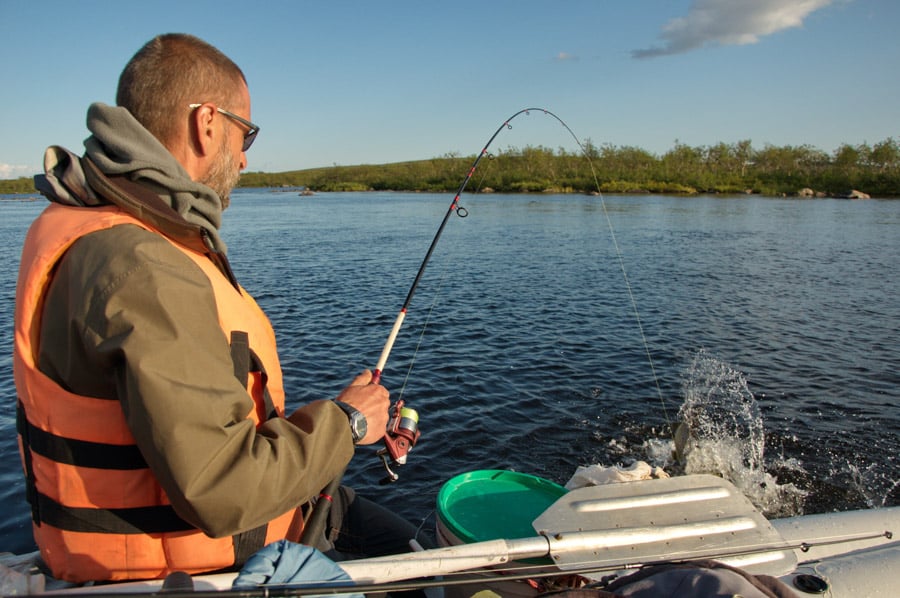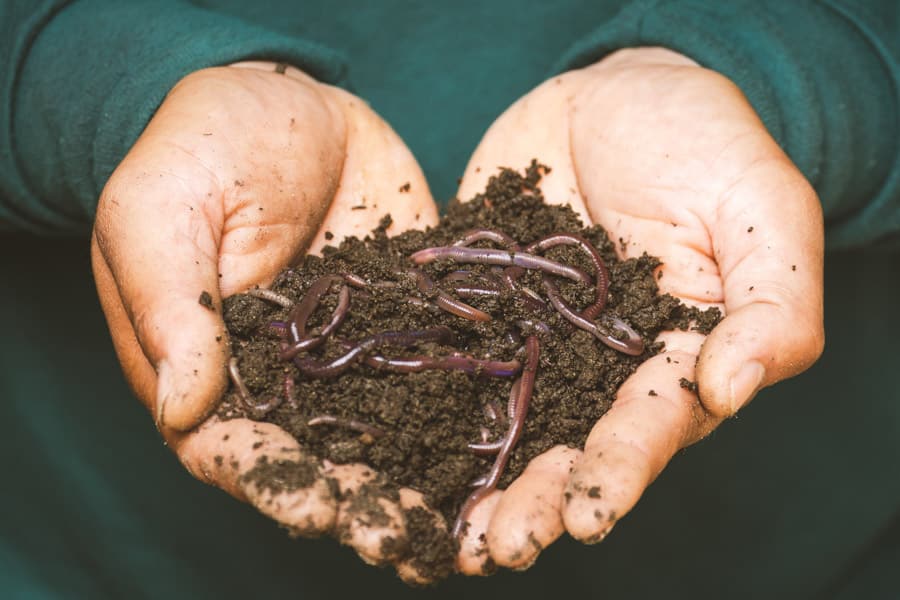I worked as a fishing guide for many years and was always asked about the most popular types of fishing. There are so many kinds of fishing that the lines blur, and we lose sight of what to use.
My time as a guide and educator taught me how to take the most popular types of fishing and make them easy to understand. I do this by looking at the big picture, then zooming in on the most popular techniques in each category.
We’re going to look at the types, styles, or methods of fishing as opposed to where people most commonly fish (e.g., freshwater vs. saltwater) or what they fish for (target species).
The most popular types of fishing are lure, bait, and fly fishing. Common fishing methods often vary by region or season, and bowfishing is growing in popularity. Though commercial fishing accounts for most of the fish harvest in the US, there are more people who fish recreationally.
For that reason, we can say that the most popular types of fishing, in terms of how many people practice it, are done recreationally. Let’s dive in and look at some common fishing methods worldwide.
How Many Different Types of Fishing are There?
While we have identified (and will explain) six popular types of fishing along with well over a dozen common fishing methods, these are just those which are particularly popular in developed countries like the US. The actual number of fishing methods cannot be quantified.
Fishing is an activity practiced all over the world. In some places, it’s a sport, but in others, it’s a subsistence activity that people use to feed themselves. The different styles of fishing are nearly endless.
Each species will live in a different area and have a different diet, so we must change our techniques and tools to fit the situation. Rods, nets, pots, spears, and traps are only a few tools used to catch fish, let alone the methods employed to use them.
Most Popular Types of Fishing
The most popular types of fishing are broadly categorized into lure, fly, bait, regional/seasonal, bow, and commercial. However, each of these types has multiple techniques that fishermen and anglers use depending on the kind of water they are fishing and what they are fishing for.
These are the most popular types of fishing and the most effective fishing methods within each category:
- Lure Fishing – Baitcaster, Float, Clear Plastic Bobber, Snap Jigging, and Topwater
- Bait Fishing – Bottom, Bobber, and Keiryu
- Fly Fishing – Traditional fly fishing, Tenkara, Spey Casting, and Euro Nymphing
- Regional and Seasonal Specialties – Trolling, Centerpin, Ice, and Ayu
- Bowfishing
- Commercial Fishing
This list also includes rising and exotic methods of fishing that many people have never heard about.
Lure Fishing Styles
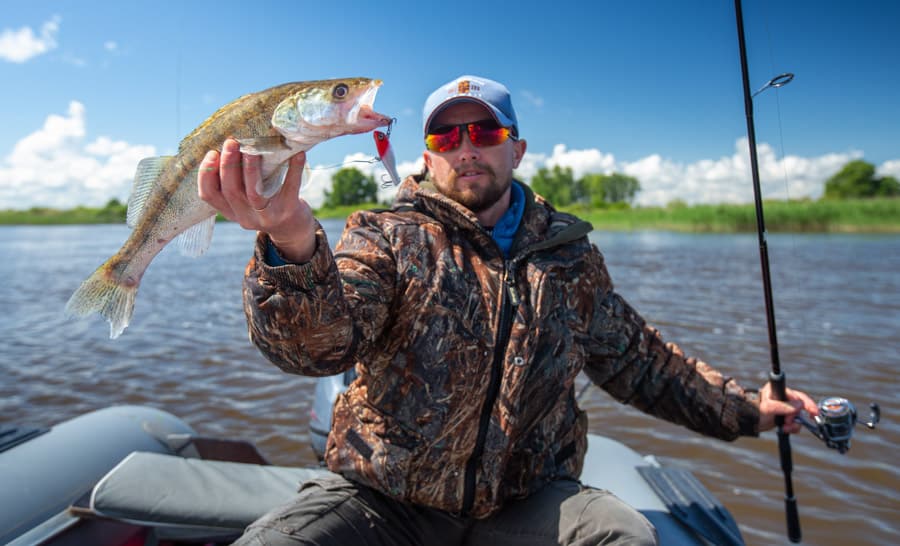
Lure fishing is a form of angling (fishing with a rod and reel) that involves using an artificial bait with a hook (a.k.a. lure) at the end of your line to catch fish. A lure is intended to mimic a fish’s prey and attract it through scent, motion, or sound as it is reeled in or propelled through the water.
Baitcaster Fishing
Baitcasting reels are free-running spools that spin to let out the line. To cast one of these, a person has to “thumb the spool.” Thumbing the spool is a simple way to slow down the spool spin rate.
People who use baitcasting reels like to use them for their accuracy when casting lures under docks or alongside weed edges.
Contrary to popular belief, there is no clear benefit between a baitcasting reel vs. a spinning reel. These reel styles can be used interchangeably for lure and bait fishing, and people’s use of them comes down to personal preference.
Float Fishing
Float fishing involves casting a floating bobber and a lure like a marabou jig or a grub. This keeps the bait higher in the water column.
The bobber can be slowly reeled, left to bob with the waves, or jerked to move the lure.
Clear Plastic Bubble Fly Fishing
Clear plastic bubble fly fishing is a style of spin fishing that lets an angler use weightless fly fishing flies. The bobber is usually made of a clear plastic that is heavily weighted. Some types can be filled with water. The bubble is nearly invisible in the water.
The fly is attached to the bubble using a leader—the fly trails behind it as an angler casts and reels.
This rig is popular for situations where a fly rod is unavailable or you’d like to cast long distances. It’s also popular among folks who want to be able to switch between flies and bait. An angler only needs to change the hook to change the lure or fly.
Snap Jigging Fishing
Snap jigging is a lure fishing technique using a blade bait or jigging rap from a boat. As the boat slowly motors, is pushed by the wind, or flows with the river’s current, you snap the rod tip up and slowly let it drop.
Keeping the lure just off the bottom makes loud vibrations in the water and entices a fish to strike the erratic bait.
Topwater Fishing
Topwater fishing is a technique that utilizes high-floating baits like poppers and frogs to skip or bubble along the surface of the water. Aggressive surface-eating fish like largemouth, smallmouth, and striped bass will attack a surface bait. This style of fishing is visual and very exciting. You never know when a fish will strike!
Bait Fishing Styles
Bait fishing is similar to lure fishing in that it uses a rod, reel, and line with a hook or “rig” at the end designed for targeting a specific kind of fish or environment. Unlike lures that rely primarily on motion and noise to attract fish, bait fishing relies more heavily on scent.
Bait fishing generally involves infrequent casting and reeling. Instead, you let your bait sit stationary or drift with the water’s current and attract fish to come and find it.
Bottom Fishing
Bottom fishing is one of the most popular types of fishing with bait and uses different bottom fishing rigs. This technique lets the worm, minnow, leech, cut bait, or crayfish sit on the bottom of the river, lake, or sea.
Since fish feed primarily on or around the bottom, bottom fishing is a high-producing technique.
Common bottom fishing rigs include:
- Slip sinker
- Fixed sinker
- Pier rig
- Float rig
- Jighead
- Split shot rig
Bobber Fishing
Bobber fishing is a style of fishing using a float to keep your bait suspended in the water column. These floats are broadly split into two groups: fixed and slip bobbers. Fixed bobbers attach to the line at a certain area and cannot move up or down until you change the orientation.
However, slip bobbers freely slide up or down the line and only stop at a “bobber stop,” which is a piece of thread tied onto the fishing line. The bobber stop is easy to adjust and can be put anywhere on the fishing line.
While a fixed bobber has a max depth of about 6 feet or less, slip bobbers can reach depths of 30 feet or more.
Keiryu Fishing
Keiryu refers to a specific kind of cane fishing pole called a keiryu rod, and this technique is gaining popularity. The exciting and unique fishing experience of catching big fish with a cane rod is second to none.
The keiryu rod is a long rod with a thicker backbone meant to fight larger fish. The bait is attached to the hook on the end of a fixed line and dropped into fish-holding areas.
This technique offers a “drag-free” drift meaning the baits can float with the exact speed of the current. This creates a natural look that won’t scare the fish away.
Without a drag-free drift, fish can tell that something is up and may ignore a bait.
Fly Fishing Styles
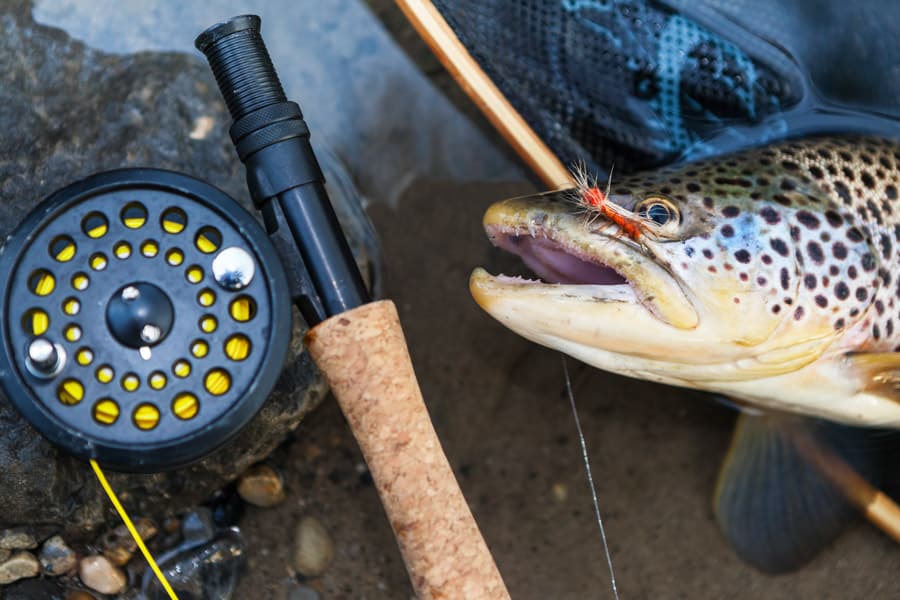
Fly fishing is also a form of angling, but it uses different equipment and attracts fish differently than lure or bait fishing. It involves a lot more casting of various types, and it generally takes longer to become proficient at it.
The most distinguishing characteristic of fly fishing is the fly at the end of the line, which attempts to mimic insects (or sometimes small animals) that fish prey upon.
Traditional Fly Fishing
Fly fishing’s origins are unclear because many cultures worldwide have historical records of fishing techniques closely resembling the fly fishing we know today. Early fly lines were made out of horse hair, and flies were often tied as a nondescript bundle of feathers and fur.
However, fly fishing in the US and Europe has a clear history all its own.
These days, fly fishing lines are made of special tapered materials so the flies are easier to cast. Since flies are nearly weightless, the fly line is used to cast the lure using specialty casting techniques such as the roll cast and the overhead cast.
Some different styles of fly fishing include:
- Dry fly fishing
- Streamer fishing
- Terrestrial fishing
- Indicator nymphing
- Swing fishing
- Popper fishing
Euro Nymphing
Euro nymphing is a tight-line fly fishing method using specialty lines and a long fly fishing rod. The flies are heavily weighted. An angler holds the rod directly above the water where it is drifting. To adjust depth, the angler only needs to raise or lower the rod tip.
This style of fishing results in a drag-free drift and is gaining in popularity. Instead of watching a strike indicator (a fly fishing bobber), the angler feels the strike with their hand. This technique is highly effective.
Tenkara Fly Fishing
Tenkara fly fishing is a technique originally created to fish mountain streams in Japan. The thick foliage and quickly moving streams would have made fly fishing with conventional gear nearly impossible.
Early anglers devised a special rod made of long bamboo and a single strand of fine hairline they could use to dabble the fly in high-producing holes and pockets. Specialty flies that kept the fly in the water while keeping tension on the line made this technique perfect for these anglers’ home waters.
Many businesses now offer tenkara rods and kits for anglers worldwide.
Spey Casting Fly Fishing
Spey casting was created to cast heavy salmon flies in waters that didn’t have enough casting room for a traditional fly cast.
The Spey rod is a long, two-handed fishing rod that uses a specialty spey cast to launch the fly. The weighted line uses a water load to bend the rod using the surface tension of the water. As it snaps forward, the line is released from a pre-formed coil in the hands.
The flies are then swung through the water and fish are caught, fought, and landed using special techniques unique to Spey casting.
Specialty Fishing Styles
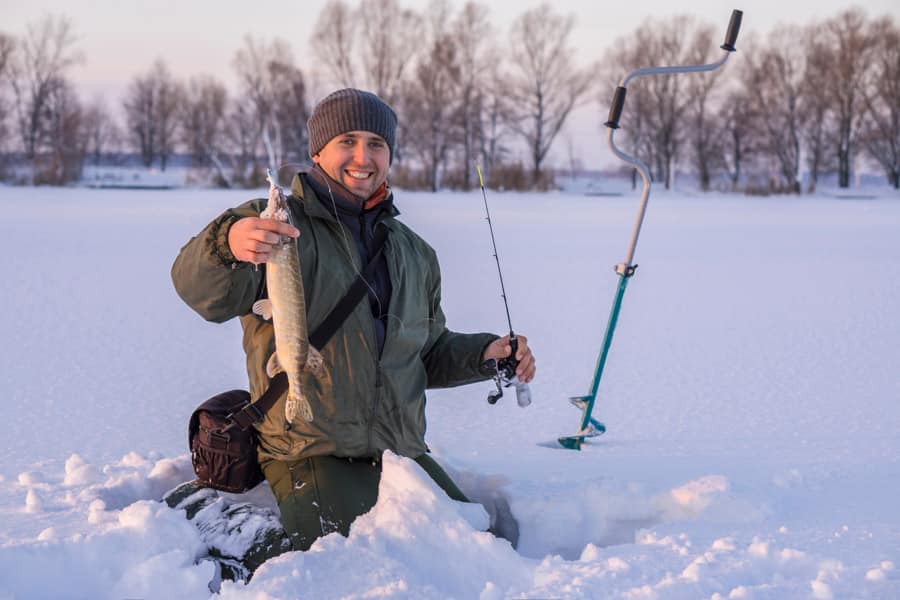
People have developed numerous ways to attract and harvest fish within their specific region or in harsh environments.
You can’t very well fly fish on a frozen lake or river. Enter ice fishing. That’s just one example. Here are a few common fishing methods developed for specific purposes.
Trolling
Trolling is a technique used for fishing from a boat. Lures and live bait are slowly pulled behind a boat as it travels. This means that the hooks are constantly in motion and is a good technique when looking for fish. It lets you cover water and offer the fish different techniques.
When trolling with bait, spinner rigs on bottom bouncers are very common. The bottom bouncer is a heavyweight with a thick wire that sits vertically in the water. The wire warns an angler when they hit bottom and prevents the rig from becoming stuck.
The spinner rig then trails behind the bottom bouncer with a minnow, worm, or leech while a small spinner swirls around the line.
When trolling with lures, common choices include spoons, spinners, and crankbaits that flutter or wobble as the lure is trolled. The fluttering action causes loud vibrations in the water that mimic live fish.
Centerpin Float Fishing
Centerpin fishing is used primarily for salmon fishing on large rivers. It allows precise control over an angler’s drift using long rods and special reels.
The “centerpin fishing reels” are called so because they have no drag system and instead spin freely around a center pin.
This technique usually involves floating specialty bobber rigs with baits like eggs sacs, fake eggs, and even worms and minnows.
Ice Fishing
When the lakes and rivers freeze over, access to the water is sealed off. However, later in the winter months, when the ice reaches at least 4 inches of clear thickness, there is enough ice so a person can safely walk on it.
Ice fishing is done by drilling a hole through the ice using a giant drill called an auger. Baits and lures are dropped straight down the hole.
Like fishing in the summer, there are specialty rods, reels, baits, and lures made just for this activity. Rods are rarely longer than three feet long, and the reels are often made so you hold part of the reel instead of the grip.
Ayu Fishing
Ayu fishing is unique to Japan and is used when targeting a specific species called ayu. The ayu is very territorial and large ayu will head butt smaller ayu if they get too close to their territory. Ayu anglers catch a small ayu, attach a circular ring to the nose, and then a single free-floating hook is attached near the head.
The smaller Ayu is then swung from a long rod into prime ayu territory as bait. When the larger ayu sitting behind a large rock or in a large eddy sees the smaller ayu in its territory, it will body slam the smaller ayu and get caught by the dangling hook.
This technique is very unique to mountainous regions in Japan and is only used when fishing for ayu.
Other Fishing Topics and Their Styles
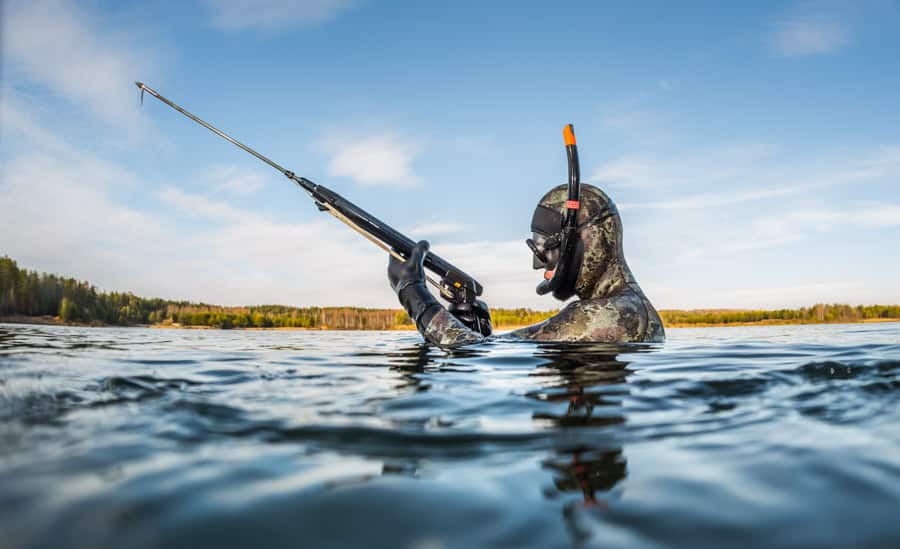
Then we have fishing methods that evolved from other activities, like hunting.
Bowfishing
Bowfishing involves using a specialty reel setup on a bow and arrow. A special arrow is attached to the string of a bow-mounted reel and allows a person to reel in a fish after it’s been struck by the arrow.
While not considered fishing by most anglers, bow fishing is gaining in popularity among the bowhunting community as a way to practice their bowhunting skills in the off-season.
Darkroom Spearfishing
Spearfishing is a technique that coincides with the ice fishing season.
First, spear anglers will cut a large hole in the ice using a special ice saw. Then, an ice fishing hut is erected over the hole to block the sunlight from above. This increases the water visibility for the spear hunters in the hut.
A decoy or live sucker is dropped into the hole, and the spear hunter waits for a predatory fish like a northern pike, muskie, or walleye to investigate the struggling food source.
When a fish is close enough, the spear hunter throws a heavily weighted spear resembling a pitchfork. They pin the fish to the bottom of the lake and attempt to lift it out. Curved barbs on the end of the spear prevent the fish from sliding off.
Spearfishing
Spearfishing is an underwater snorkeling technique where participants use a pole spear or spear gun to shoot and capture their quarry. This technique is most common near the ocean.
A spear hunter will do long breath holds as they swim in the water looking for prey. They will shoot the fish, lobster, or other species when they see one and swim back to the surface.
Their speargun is often attached to a float on the water’s surface. Some spearguns have an attached reel that can be used to reel in the fish after it’s been shot. This way, the fish can tire itself out, and the spear fisherman can swim back to the prey on the next breath hold.
Commercial Trawling Fishing
Trawling is a method used only by large boats. It involves setting out long nets that are towed behind a boat. When the net is filled with fish, a trawling boat pulls the net to the surface and drops the load in storage and sorting areas on the boat’s deck.
Trawling is very effective. However, it’s so effective that overfishing can decimate a fishery’s health. Special regulations, research, and studies are in place to prevent this.
Conclusion
The most popular types of fishing are broadly categorized into lure, fly, bait, regional, bow, and commercial.
Regardless of the technique and the type of fish, we should always follow ethical fishing practices. Wetting our hands before touching the fish we plan to release is an excellent way to protect their slime coat.
Doing our research and asking folks for help is a simple way to take our skills to the next level. There are so many different fishing styles, it’s fun to try them all!
Types of Fishing FAQs
What is the most common type of fishing?
The most common type of fishing is bait fishing. Bait fishing is the method that most people use when they first start. Bait fishing is also extremely effective around the world for everything from minnows to sharks.
What is the best type of fishing?
The best type of fishing is based on the water and the fish we are targeting. I determine the best type of fishing for each situation by accounting for factors like time of year, type of fish, weather, gear, and many other things.
The best type of fishing is the one that works at the right time and place on your local waters.
Where is fishing the most popular?
There is no single place where fishing is the most popular. Why? Every region that has access to water has a community of anglers.
That said, fishing is very popular along coastal towns and islands. Many inland states with lots of water, like Minnesota, or unique fishing environments like Colorado are home to thriving fishing communities.

